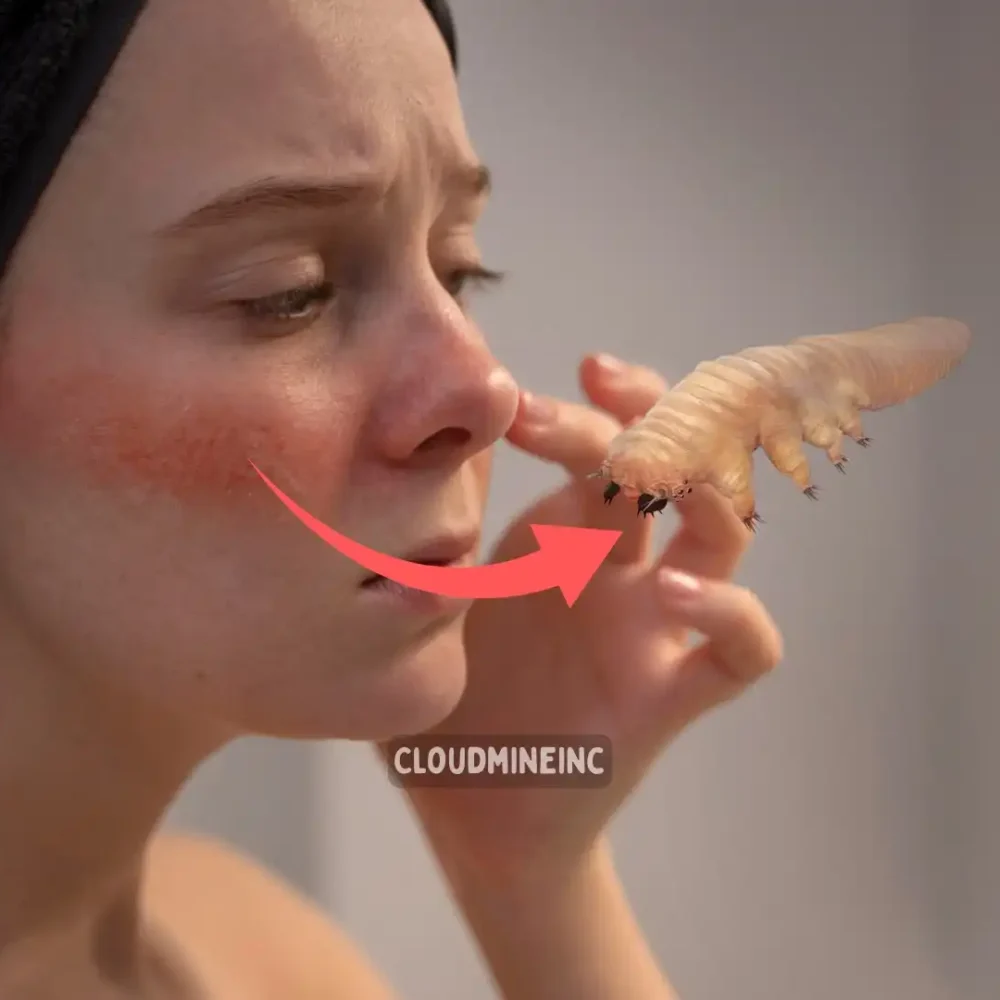
Last Updated on August 28, 2025 by Beth Skwarecki
You’ve probably stumbled across this article because you’re dealing with some annoying skin issues, right? Maybe you’ve got that weird crawling sensation on your skin, or perhaps your face looks like it’s hosting a red-dot convention. Well, here’s some good news—those pesky Demodex mites might actually be on their way out!
But here’s the thing: recognizing the signs Demodex mites are dying isn’t always straightforward. Sometimes your skin gets worse before it gets better (yeah, I know, life’s cruel like that). Let me walk you through what to expect when these microscopic freeloaders finally start packing their bags.
What Are Demodex Mites Anyway?
Before we jump into the good stuff, let’s quickly cover what we’re dealing with here. Demodex mites are tiny microscopic parasites that basically treat your face like a five-star hotel. They live in your hair follicles and oil glands, munching on dead skin cells and oils.
Here’s what makes them particularly annoying:
- They’re mostly found on your face, eyelids, and eyelashes
- They can cause hair loss, rosacea, acne, and blepharitis
- They’re most active at night (because apparently, they’re night owls too)
- Everyone has them, but some people’s mites throw bigger parties than others
The two main troublemakers are Demodex folliculorum and Demodex brevis. Think of them as the annoying roommates who overstay their welcome and eat all your food.
Early Signs Your Mite Treatment is Working
The Initial Flare-Up (Don’t Panic!)
Here’s where things get a bit weird. When you first start treating Demodex mites, your skin might actually get worse before it gets better. I know, I know—it sounds backwards, but there’s a good reason for this.
When the mites start dying off, they release toxins and bacteria that can trigger inflammatory responses. It’s like they’re throwing one last tantrum before they leave. This mite die-off phase can make your existing symptoms more intense for a few days or weeks.
But here’s the silver lining: this flare-up is actually a positive sign that your treatment is working! Think of it as the calm before the storm—except it’s the storm before the calm 🙂
The Crawling Sensation Disappears
One of the first signs Demodex mites are dying is when that creepy-crawly feeling on your skin starts to fade. You know that sensation—like tiny bugs are having a dance party on your face? Yeah, that one.
When patients use effective treatments, especially scalp detox products, they often report that this crawling sensation is among the first things to disappear. It’s like finally getting those unwanted party guests to leave your house!
Red Dots and Bumps Start Vanishing
Ever wake up in the morning looking like you’ve been attacked by angry mosquitoes? Those red dots and bumps are often worse in the morning because Demodex mites are most active at night. As the mites start dying off, you’ll notice fewer of these morning surprises.
This improvement happens gradually, but it’s one of the clearer signs Demodex mites are dying. Your mirror will become your friend again—trust me on this one.
Physical Changes You’ll Notice
Your Skin Texture Improves
Remember when your skin felt smooth? As the mite die-off progresses, you’ll start feeling that smoothness returning. The rough, uneven texture that made your face feel like sandpaper will gradually improve.
This happens because the mites were essentially clogging your pores and causing micro-inflammation. When they’re gone, your skin can finally breathe again.
Reduced Redness and Inflammation
Those angry red patches that made you look like you’d been out in the sun too long? They’ll start calming down as the Demodex mites population decreases. The inflammation that comes with mite overpopulation begins to subside, giving your skin a chance to heal.
This is particularly noticeable if you’ve been dealing with rosacea or acne-like symptoms. Your skin tone will start evening out, and that constant irritation will fade.
Pores Look Smaller and Less Clogged
Here’s something cool—as the mites die off, your pores will appear smaller and less congested. This happens because the mites and their waste products were literally clogging up your follicles. Once they’re gone, your pores can return to their normal size.
Your skin will also start absorbing skincare products better. It’s like removing a traffic jam on your face!
Advanced Signs of Successful Treatment
Less Intense Die-Off Cycles
As your treatment progresses, you’ll notice that the die-off cycles become milder and shorter. Initially, you might experience intense flare-ups every few weeks. But as the mite population decreases, these cycles become less dramatic.
This is one of the most reliable signs Demodex mites are dying because it shows that there are fewer mites left to cause problems.
Your Skin’s Moisture Needs Change
This one’s interesting—you might find that your skin’s hydration needs change during treatment. If you’ve been slathering on heavy moisturizers to combat dryness, you might find you need less as the mites die off.
This happens because the mites were disrupting your skin’s natural moisture balance. Once they’re gone, your skin can regulate itself better.
Skincare Products Work Better
Ever felt like your expensive skincare products weren’t doing much? As the mite die-off progresses, you’ll notice that your products start working more effectively. They’ll absorb better, and you might even find that your makeup lasts longer.
This improvement occurs because there’s no longer a layer of mites and debris blocking your products from penetrating your skin properly.
Eye-Related Improvements

Ocular Rosacea Symptoms Improve
If you’ve been dealing with red, itchy, dry eyes (thanks to Demodex mites on your eyelashes), you’ll start noticing relief as the mites die off. The light sensitivity that made you feel like a vampire will decrease, and your eyes will feel more comfortable.
Blepharitis symptoms—that annoying eyelid inflammation—will also start clearing up. Your eyelids won’t feel as heavy or irritated.
Eyelashes Look Healthier
This might seem minor, but it’s actually a great indicator. As the mites on your eyelashes die off, your lashes will look fuller and healthier. They won’t have that crusty, flaky appearance anymore.
Timeline: What to Expect
Here’s the reality check—mite die-off isn’t an overnight process. The Demodex lifecycle is about 2-3 weeks, so you’re looking at multiple cycles before you see significant improvement.
- Week 1-2: Initial flare-up (this is normal!)
- Week 3-4: Crawling sensations start decreasing
- Week 5-8: Noticeable improvement in skin texture and redness
- Week 9-12: Significant reduction in symptoms
- Month 3+: Skin stabilizes and flare-ups become rare
Remember, everyone’s timeline is different. Some people see improvements faster, while others need more patience (and more Netflix to binge while waiting).
Treatment Approaches That Work
Topical Treatments
The most common treatments include:
- Tea tree oil (diluted, please—don’t burn your face off)
- Permethrin cream
- Benzoyl peroxide
- Metronidazole gel
Oral Medications
For severe cases, doctors might prescribe:
- Ivermectin
- Antibiotics (usually doxycycline)
Natural Approaches
FYI, some people prefer gentler methods:
- Regular cleansing with sulfur-based products
- Warm compresses
- Anti-inflammatory diet changes
Red Flags: When to See a Doctor
While mite die-off symptoms are normal, some signs warrant professional attention:
- Symptoms getting significantly worse after 4 weeks of treatment
- Signs of secondary bacterial infection
- Severe swelling, itchiness or pain
- Pustules or blisters forming on the affected areas
- Signs of scabies infestation in young children (i.e. crusted scabies)
Remember to consult a doctor if you experience any of these symptoms and do not see improvement after treatment. It is important to properly manage scabies to prevent further complications and transmission to others.
FAQs
Patience Pays Off in the Fight Against Demodex
Dealing with Demodex mites can feel frustrating, especially when your skin seems to rebel before it heals. But remember—those flare-ups, changes in texture, and gradual improvements are all signs that your treatment is working. The key is consistency, patience, and listening to your skin as it adjusts.
Over time, as the mite population decreases, you’ll notice clearer skin, calmer eyes, and a healthier overall complexion. Stick with your treatment plan, keep an eye out for red flags, and celebrate each small victory—because every step forward means you’re closer to winning the battle against these microscopic freeloaders.

Diana shares expert-backed beauty and skincare tips to help readers achieve healthy, glowing skin. From natural remedies to the latest skincare trends, Diana focuses on practical advice that makes self-care simple, effective, and confidence-boosting.